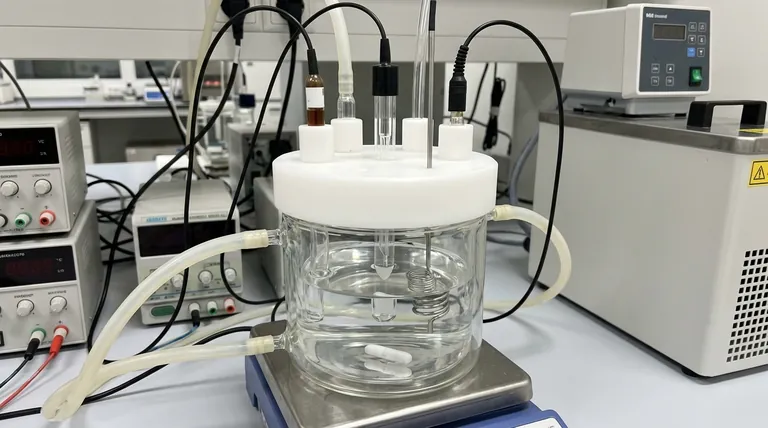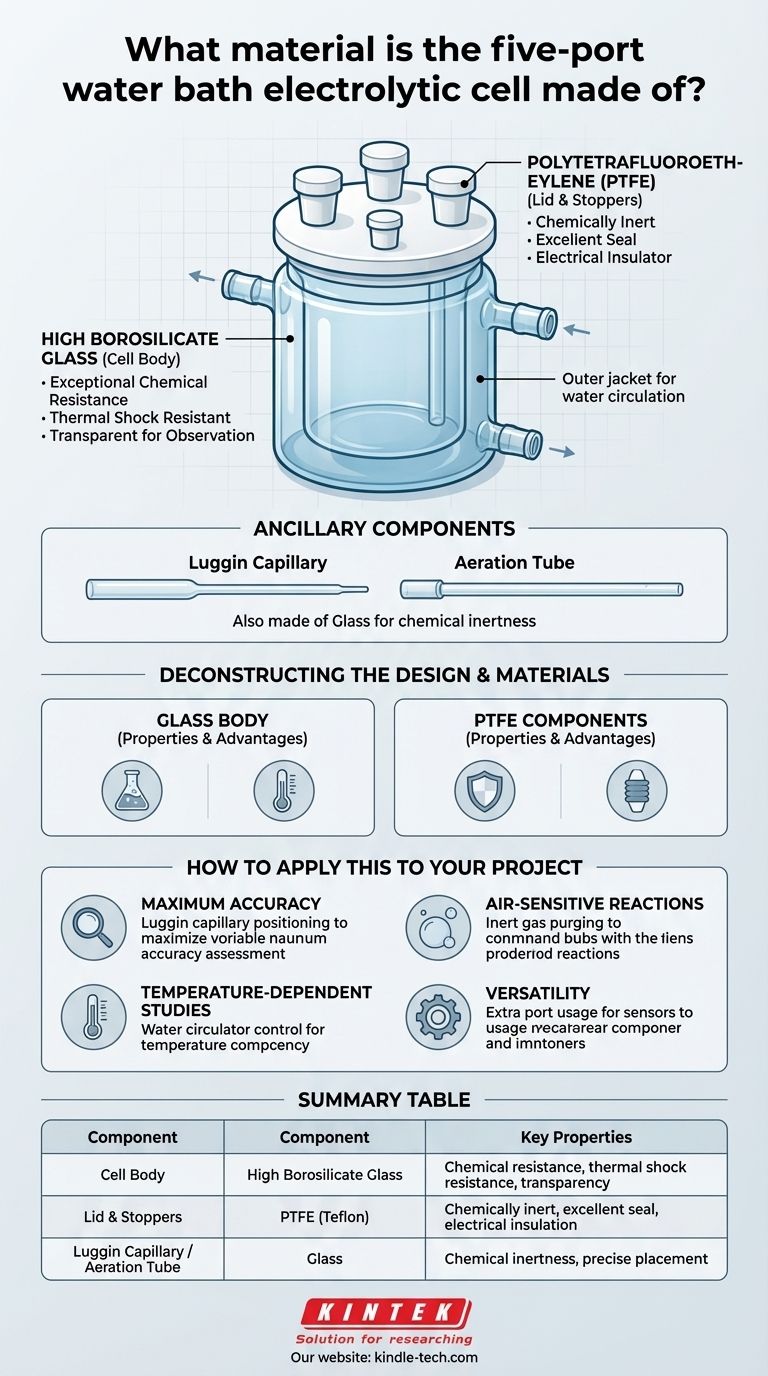At its core, a five-port water bath electrolytic cell is constructed from two primary materials designed for electrochemical stability and experimental control. The main body of the cell is made of high borosilicate glass, while the lid and stoppers are typically machined from Polytetrafluoroethylene (PTFE).
The combination of high borosilicate glass and PTFE provides the necessary chemical inertness, thermal stability, and electrical insulation required for precise and repeatable electrochemical measurements. Understanding why these materials are chosen is key to conducting successful experiments.

Deconstructing the Materials and Design
The specific materials are not arbitrary; each is selected for a critical function within an electrochemical setup. They work together to create a controlled and non-interfering environment for your reaction.
The Cell Body: High Borosilicate Glass
The choice of high borosilicate glass for the cell's body is deliberate. This material offers exceptional chemical resistance, ensuring it does not react with the vast majority of electrolytes or solvents used in experiments.
Its primary advantage is its low coefficient of thermal expansion. This makes it highly resistant to thermal shock, a critical feature for a "water bath" cell where temperature is controlled by circulating liquid through an outer jacket.
Finally, its transparency allows for direct visual observation of the experiment, such as monitoring gas bubble formation on an electrode or noting color changes in the solution.
The Lid and Stoppers: Polytetrafluoroethylene (PTFE)
The lid and the stoppers that seal the ports are made from PTFE, a fluoropolymer widely known by the brand name Teflon. PTFE is one of the most chemically inert plastics available, resisting attack from even highly aggressive acids and bases.
This material provides an excellent seal to isolate the internal cell environment from the outside atmosphere. It is also a superb electrical insulator, which is crucial for preventing short circuits between the electrodes that enter through the lid.
The Ancillary Components
The standard configuration also includes components like a Luggin capillary and an aeration tube. These are typically made of glass to maintain the chemical inertness of the system. The Luggin capillary's specific function is to minimize a measurement error known as IR drop by placing the reference electrode tip very close to the working electrode's surface.
Understanding the Trade-offs and Handling
While this material combination is ideal for most applications, it is essential to be aware of its inherent limitations and proper handling procedures.
The Fragility of Glass
The most significant trade-off is the fragility of the glass cell body. It must be handled with care at all times. Clamping it too tightly in a stand or subjecting it to physical impact can easily cause it to crack or shatter.
PTFE Sealing and Temperature Limits
While PTFE offers an excellent seal, it is a softer material. Overtightening electrodes or components in the ports can deform the PTFE, potentially compromising the seal over time. Furthermore, while it has a wide operating temperature range, its structural integrity can be affected at extreme temperatures not typically seen in water bath experiments.
The Importance of Port Configuration
A standard five-port cell is designed for flexibility. The typical setup accommodates the three essential electrodes (working, counter, reference), a gas inlet/outlet for purging the solution, and a fifth port for a sensor like a thermometer or for adding reagents. Ensure the port diameters match your specific electrodes or components.
How to Apply This to Your Project
Properly utilizing the features of a five-port cell is critical for obtaining high-quality data. Your experimental goal should dictate your setup.
- If your primary focus is maximum accuracy: Position the Luggin capillary tip as close as possible to the working electrode surface without touching it to minimize IR drop.
- If your primary focus is studying air-sensitive reactions: Use the gas inlet port to continuously bubble an inert gas (like nitrogen or argon) through your electrolyte to remove dissolved oxygen.
- If your primary focus is temperature-dependent studies: Ensure your water circulator is connected correctly to the cell's outer jacket and set to the precise temperature required for your experiment.
- If your primary focus is versatility: Use the extra ports to add a pH meter, thermometer, or a rotating disk electrode to gather multiple data streams simultaneously.
Understanding the role of each material and component empowers you to configure your electrochemical cell for the most reliable and reproducible results.
Summary Table:
| Component | Material | Key Properties |
|---|---|---|
| Cell Body | High Borosilicate Glass | Chemical resistance, thermal shock resistance, transparency |
| Lid & Stoppers | PTFE (Teflon) | Chemically inert, excellent seal, electrical insulation |
| Luggin Capillary / Aeration Tube | Glass | Chemical inertness, precise reference electrode placement |
Ready to configure your ideal electrochemical setup?
The right equipment is fundamental to achieving precise, reproducible results. KINTEK specializes in high-quality lab equipment and consumables, including electrochemical cells and accessories, to serve your laboratory's specific needs.
Let our experts help you select the perfect cell for your application. Contact us today to discuss your project requirements and discover the KINTEK advantage in reliability and performance.
Visual Guide

Related Products
- Electrolytic Electrochemical Cell with Five-Port
- Double Layer Five-Port Water Bath Electrolytic Electrochemical Cell
- Double-Layer Water Bath Electrolytic Electrochemical Cell
- H-Type Double-Layer Optical Electrolytic Electrochemical Cell with Water Bath
- Electrolytic Electrochemical Cell for Coating Evaluation
People Also Ask
- How should the body of an electrolytic cell be maintained for longevity? Extend Your Equipment's Lifespan
- What are the proper storage procedures for the multifunctional electrolytic cell? Protect Your Investment and Ensure Data Accuracy
- What are the standard components of the five-port water bath electrolytic cell? Master the Precision Instrument for Electrochemical Analysis
- How can leaks be prevented when using a five-port water bath electrolytic cell? Ensure a Reliable and Safe Electrochemical Setup
- What general precaution should be taken when handling the electrolytic cell? Ensure Safe and Accurate Lab Results



















